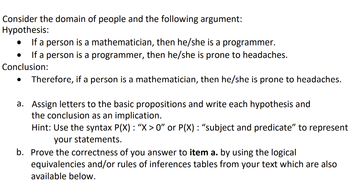
A First Course in Probability (10th Edition)
10th Edition
ISBN: 9780134753119
Author: Sheldon Ross
Publisher: PEARSON
expand_more
expand_more
format_list_bulleted
Question

Transcribed Image Text:Consider the domain of people and the following argument:
Hypothesis:
If a person is a mathematician, then he/she is a programmer.
If a person is a programmer, then he/she is prone to headaches.
Conclusion:
Therefore, if a person is a mathematician, then he/she is prone to headaches.
a. Assign letters to the basic propositions and write each hypothesis and
the conclusion as an implication.
●
Hint: Use the syntax P(X) : “X > 0” or P(X) : “subject and predicate" to represent
your statements.
b. Prove the correctness of you answer to item a. by using the logical
equivalencies and/or rules of inferences tables from your text which are also
available below.
Expert Solution
arrow_forward
Step 1
Sol:-
a. Let's assign letters to the basic propositions:
- P: "A person is a mathematician."
- Q: "A person is a programmer."
- R: "A person is prone to headaches."
The hypotheses and conclusion can then be written as implications:
- Hypothesis 1: P → Q ("If a person is a mathematician, then he/she is a programmer.")
- Hypothesis 2: Q → R ("If a person is a programmer, then he/she is prone to headaches.")
- Conclusion: P → R ("Therefore, if a
Trending nowThis is a popular solution!
Step by stepSolved in 2 steps

Knowledge Booster
Similar questions
- Help me fast so that I will give Upvote.arrow_forwardContrast a truth table for the statement pV~parrow_forwardii. Let F(x,y) be the open sentence "x can fool y" where the domain of discourse is the set of all people in the world. Express each of these statements using logical quantifiers. c. Everybody can fool somebody. e. Everyone can be fooled by somebody. f. There is somebody who can be fooled by everybody.arrow_forward
- Using relational predicates ( e.g. F(s,m) for, say, s can fool m), translate the following sentences into predicate logic. You can use English words for the quantification symbols (such as For All x instead of v x) if necessary Also give the negatives of each sentence in English. a) Everybody can fool somebody b) There is no-one who can fool everyone. For the toolbar, press ALT+F10 (PC) or ALT+FN+F10 (Mac).arrow_forwardUse the truth table test of validity to determine whether the following arguments are valid or invalid. To be invalid, the premises will be true, but the conclusion false. INSTRUCTIONS: 1. First, identify and define the type of Truth Functional Connective each symbol represents and type it in to the first table. 2. Then, create a Formal Method Test of validity table below each argument to determine whether the argument is valid or invalid. 3. Indicate whether the argument is valid or invalid. If the argument is invalid, highlight the area on the table that proves it. A row for each possible outcome [2"] → Use the pattern of half the rows to make half of the values in the column true → For the next column keep using the pattern of half Remember to Create: Type in the meaning of the symbol in the space provided. Truth Functional Symbol How to determine its truth value Connective it represents V .. SAMPLE ARGUMENT: 1. P• Q 2. .. Pv Q How many atomic propositions? = How many rows 2ª (+1…arrow_forwardA student club holds a meeting. The predicate M(x) denotes whether person x came to the meeting on time. The predicate O(x) refers to whether person x is an officer of the club. The predicate D(x) indicates whether person x has paid his or her club dues. The domain is the set of all members of the club. The names of the members and their truth values for each of the predicates is given in the following table. Indicate whether each expression is true or false. If a universal statement is not true, give a counterexample. If an existential statement is true, give an example. Name M(x) O(x) D(X) Hillary T F Bernie F F Donald F F Jeb F Carly F F Ex (M(x) A D(x)arrow_forward
- 2. Let P(x) be "x is a student in this class," Q(x) be “x knows how to write programs in Python," and R(x) be “x can get a good job," where the domain of x consists of all people. Write the following argument in argument form and use the rules of inference to show that the argument is valid. Tom is a student in this class. Tom knows how to write programs in Python. Everyone who knows how to write programs in Python can get a good job. Therefore, some student in this class can get a good job.arrow_forwardConsider the following argument: If the white flag is flying, then truce has been declared. Truce has not been declared. Therefore, the white flag is not flying. (a) Define statement variables for each component of the above argument, then write the formal argument using your variables. (b) Is the above argument valid? Explain. c) Find the contrapositive of the statement, “If the white flag is flying, then truce has been declared.” d) If the statement “If the white flag is flying, then truce has been declared” is replaced with its contrapositive, will the above argument be valid? Why or why not?arrow_forward
arrow_back_ios
arrow_forward_ios
Recommended textbooks for you
 A First Course in Probability (10th Edition)ProbabilityISBN:9780134753119Author:Sheldon RossPublisher:PEARSON
A First Course in Probability (10th Edition)ProbabilityISBN:9780134753119Author:Sheldon RossPublisher:PEARSON

A First Course in Probability (10th Edition)
Probability
ISBN:9780134753119
Author:Sheldon Ross
Publisher:PEARSON
